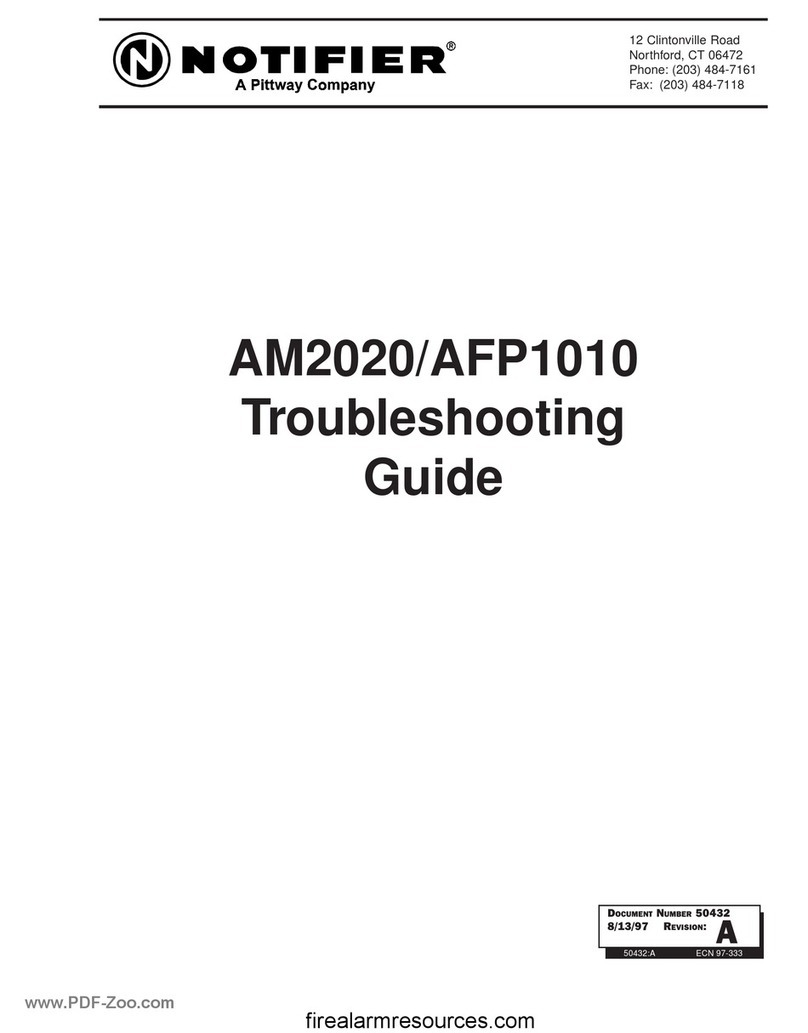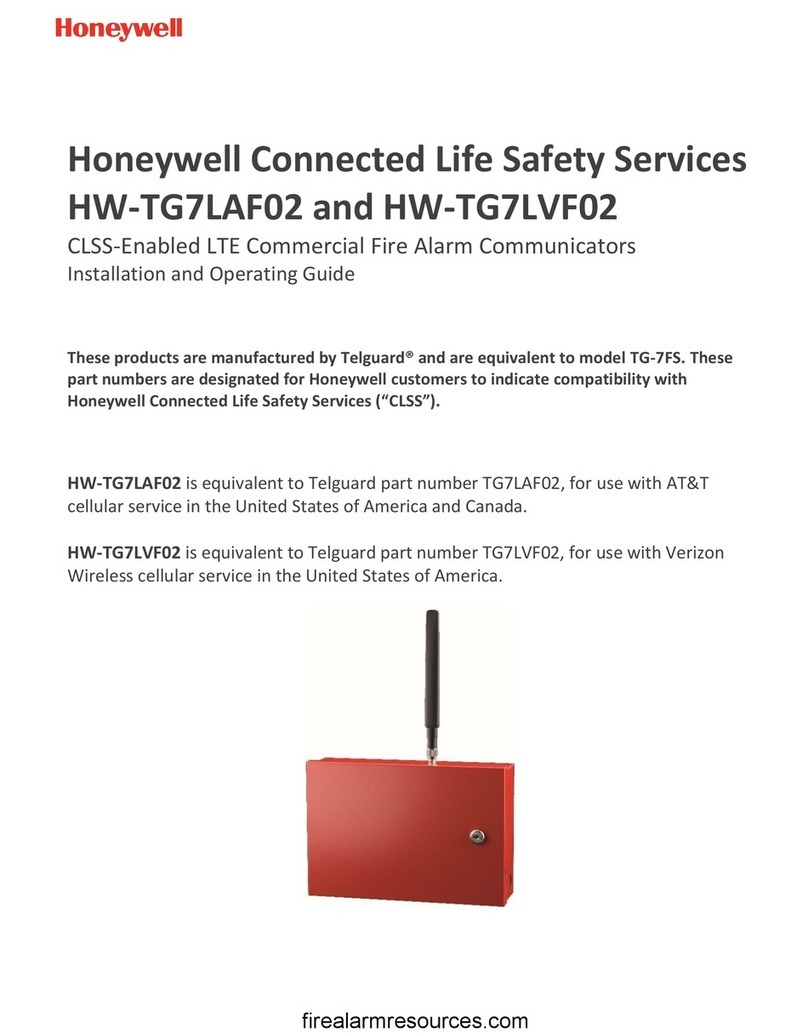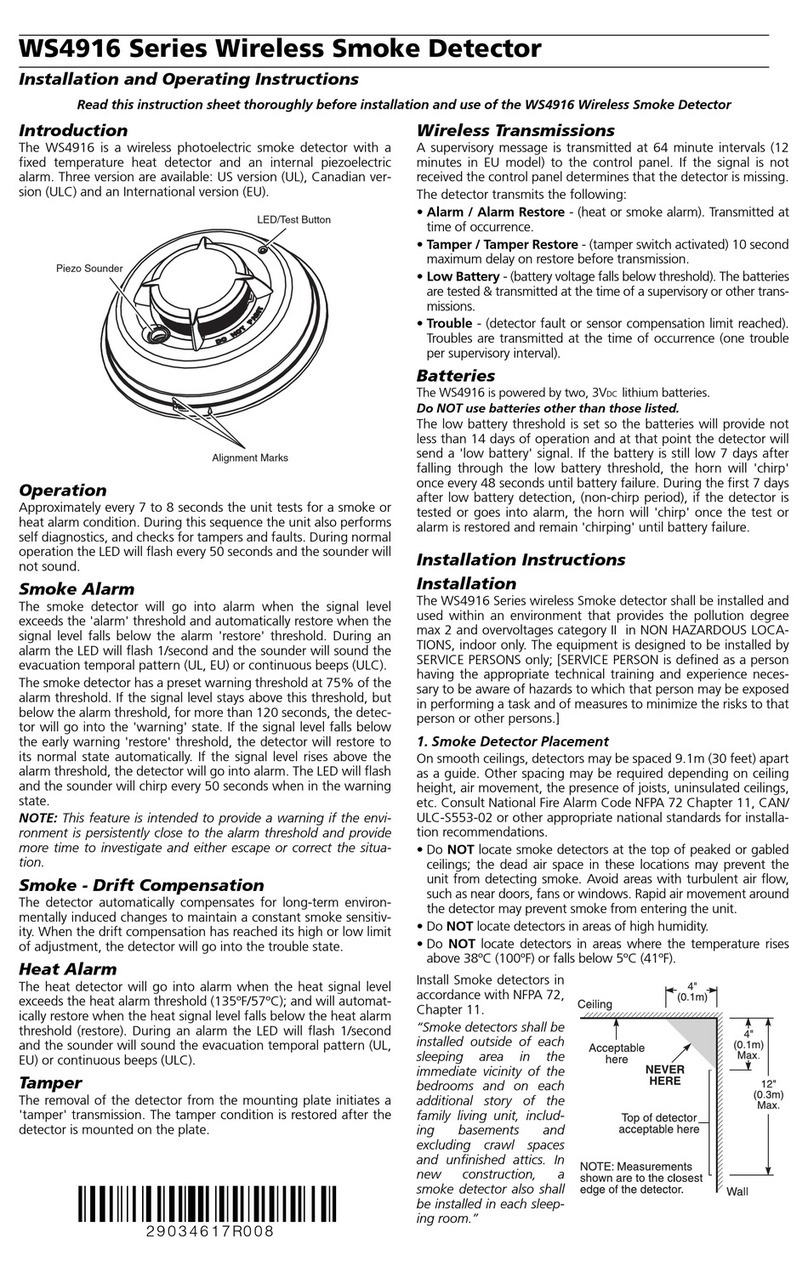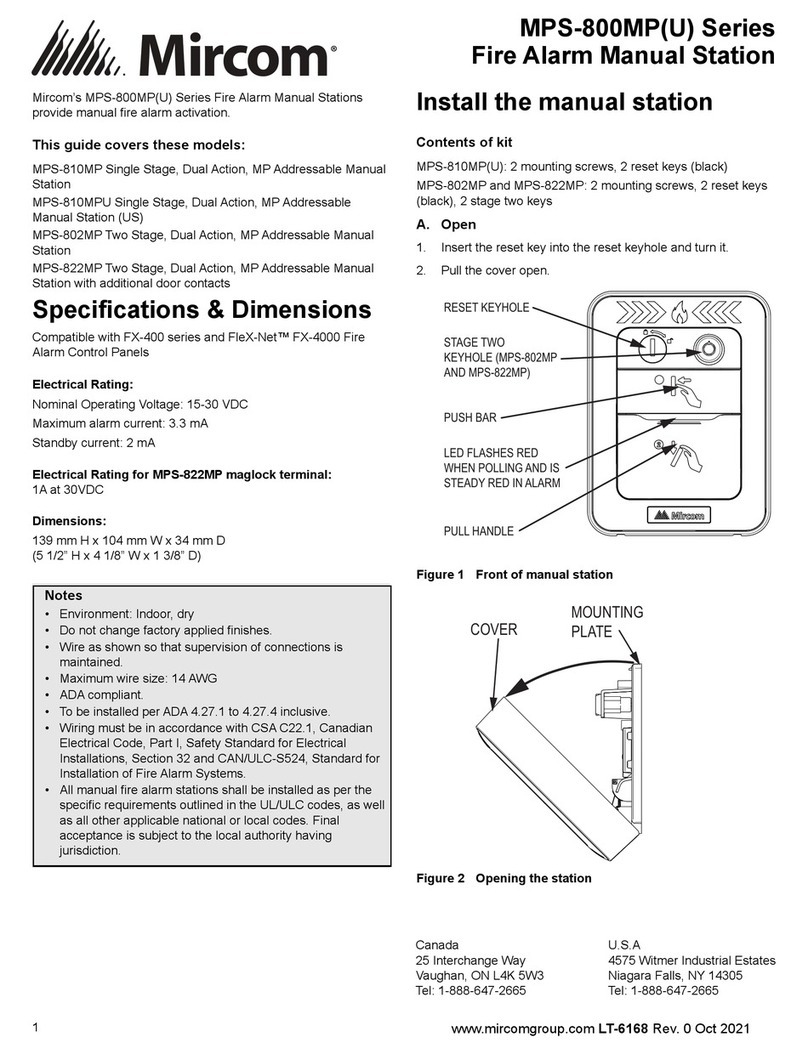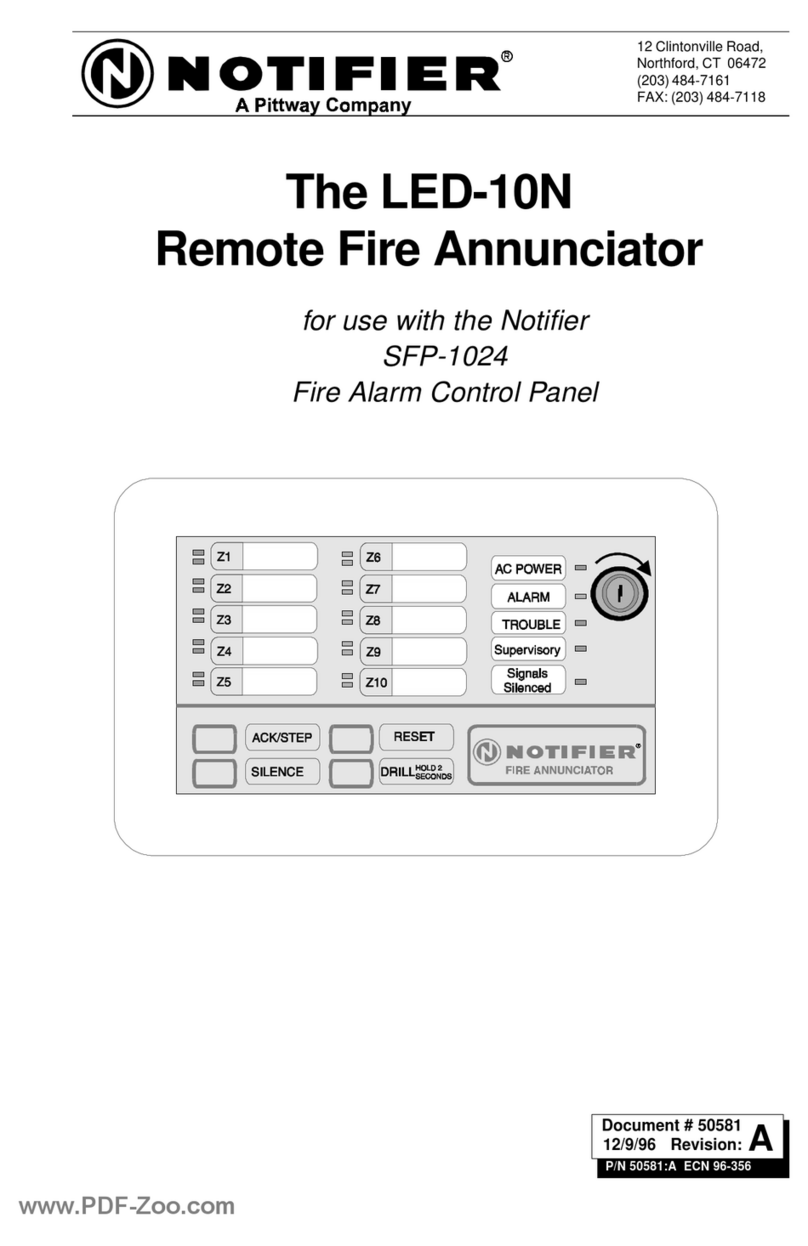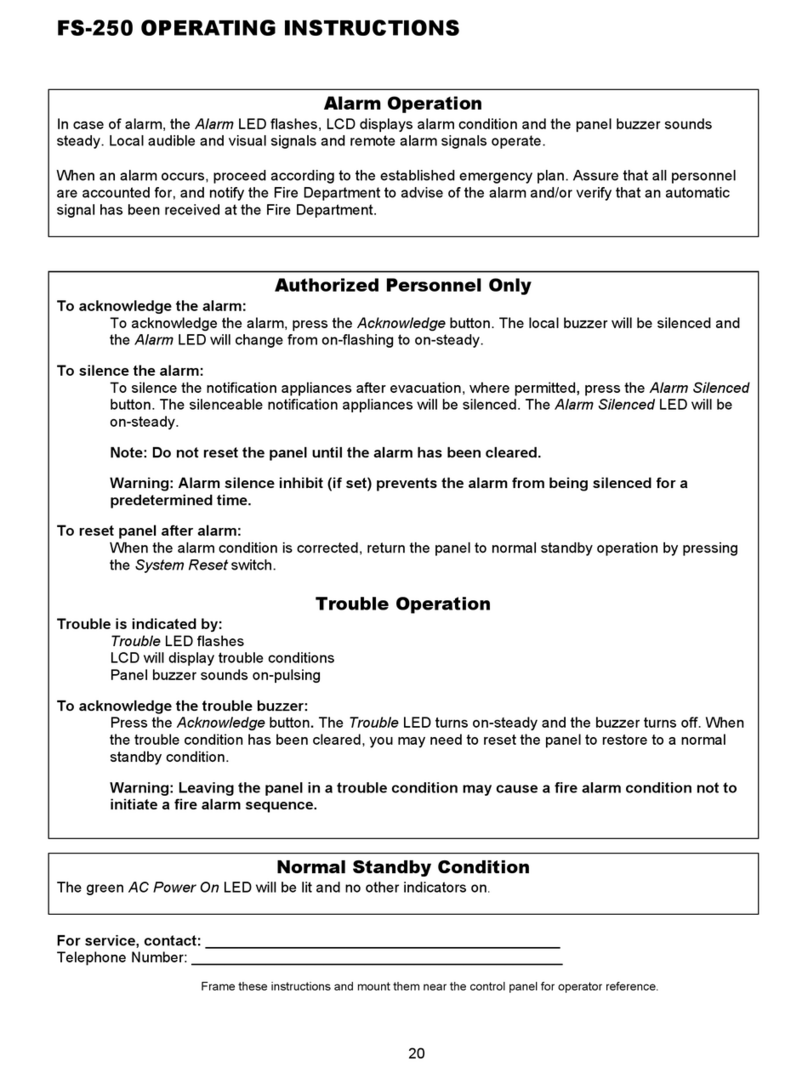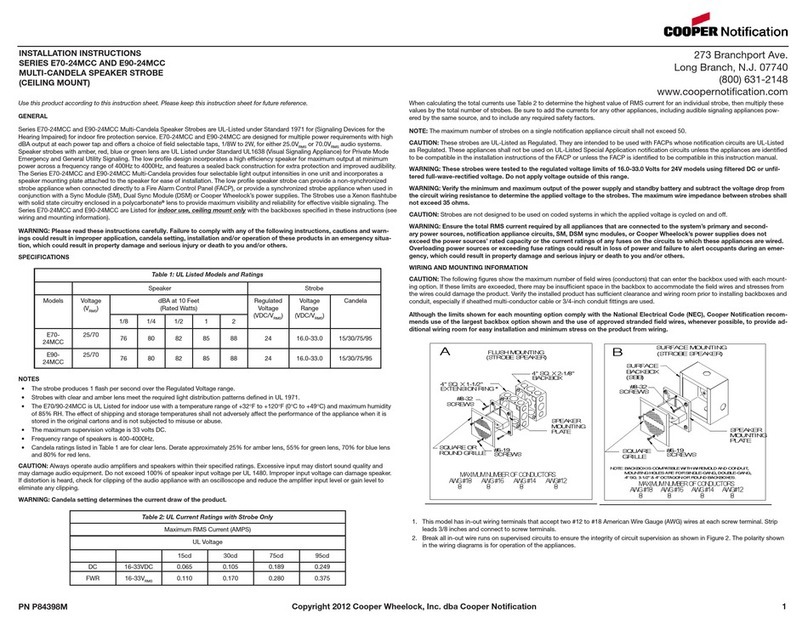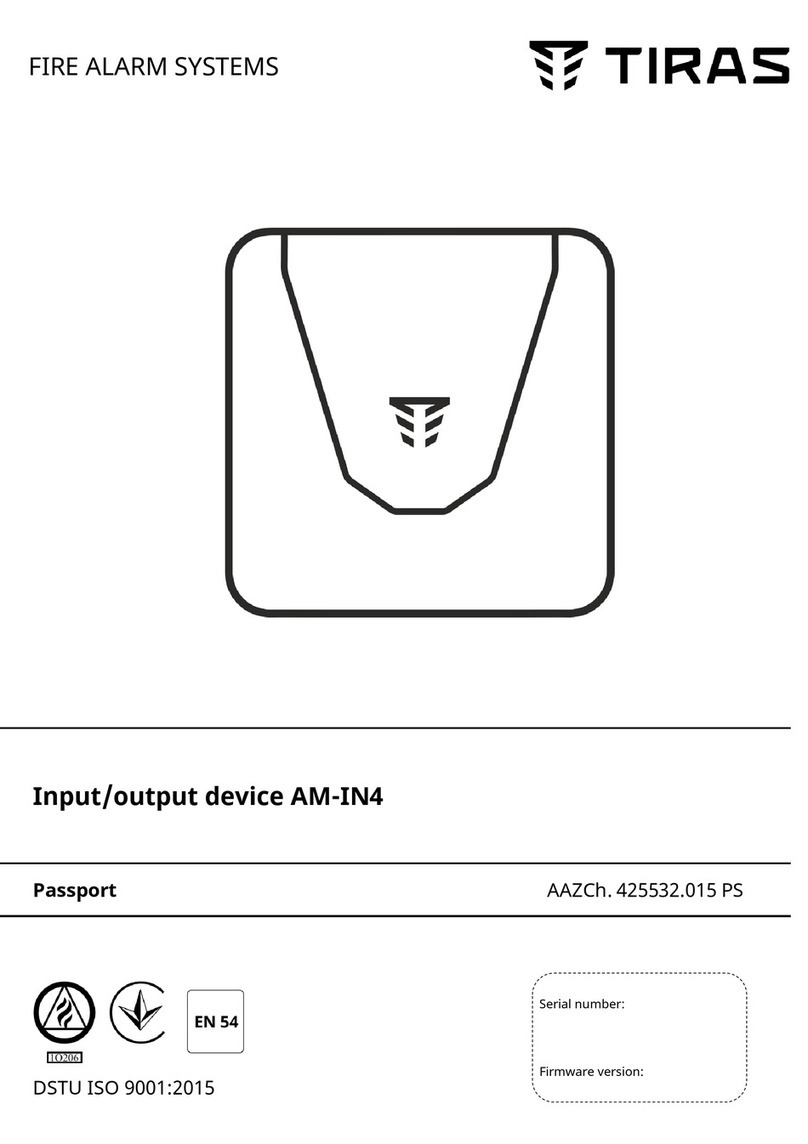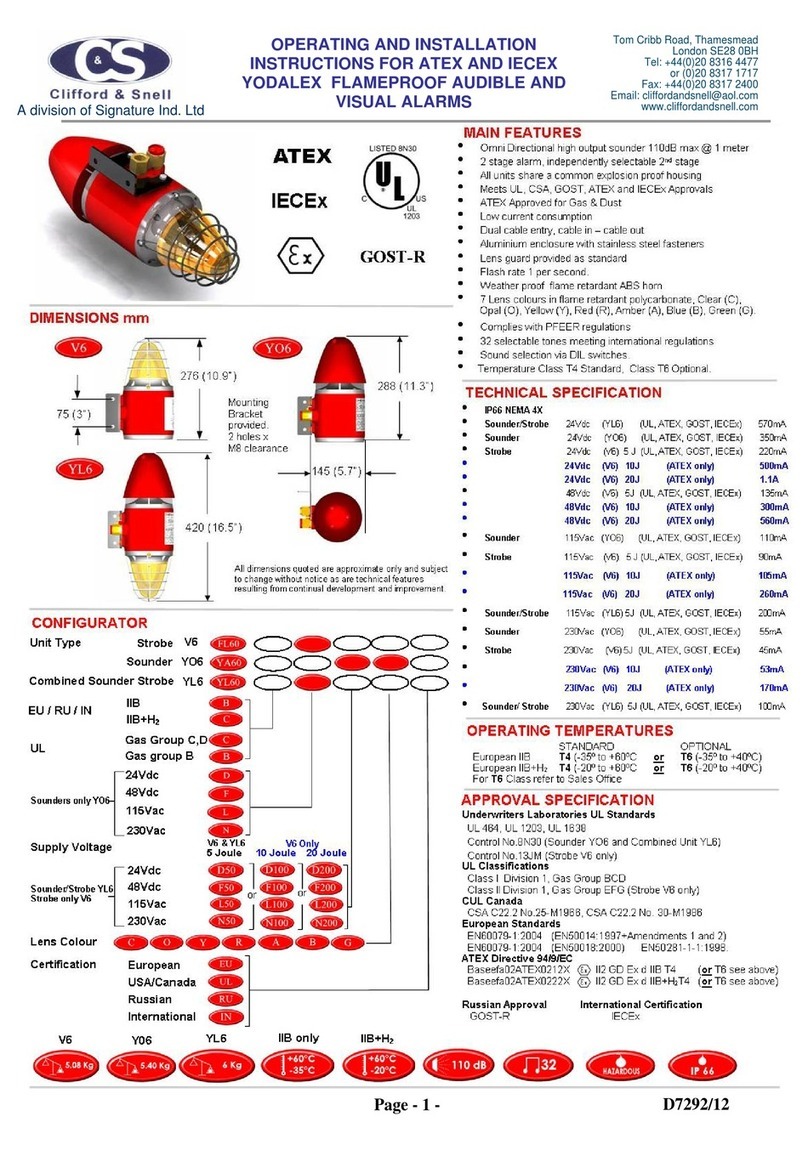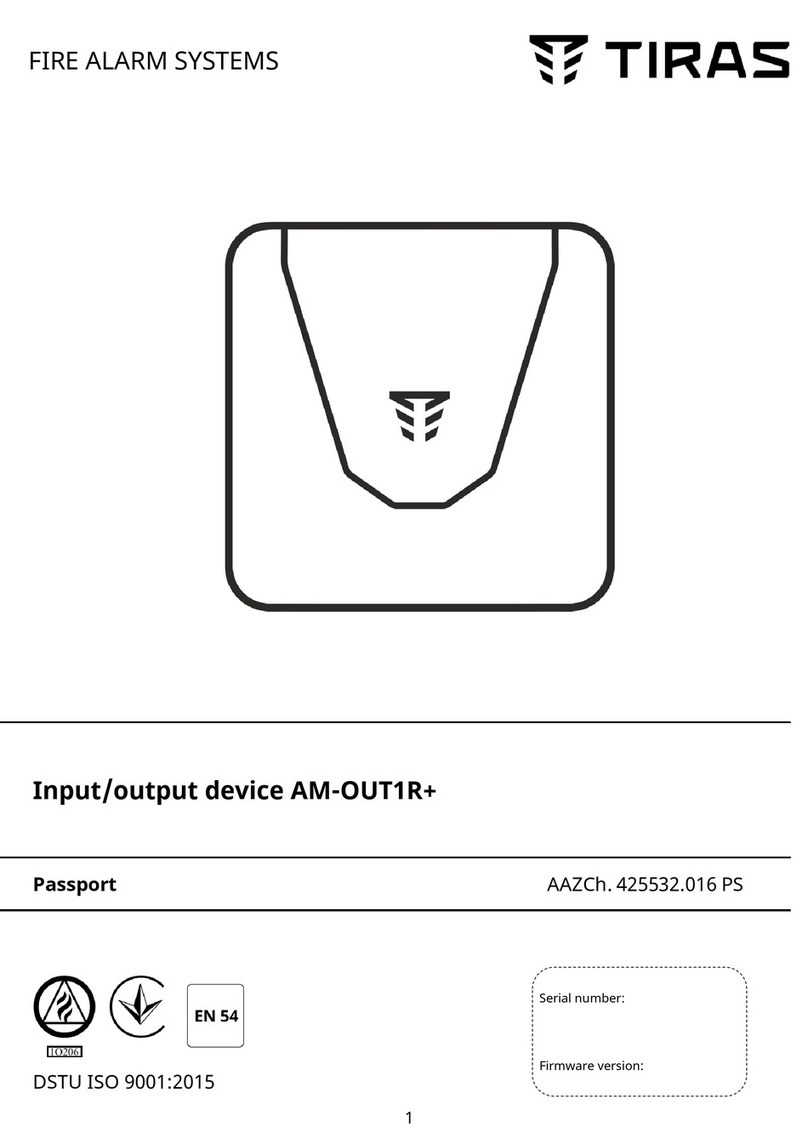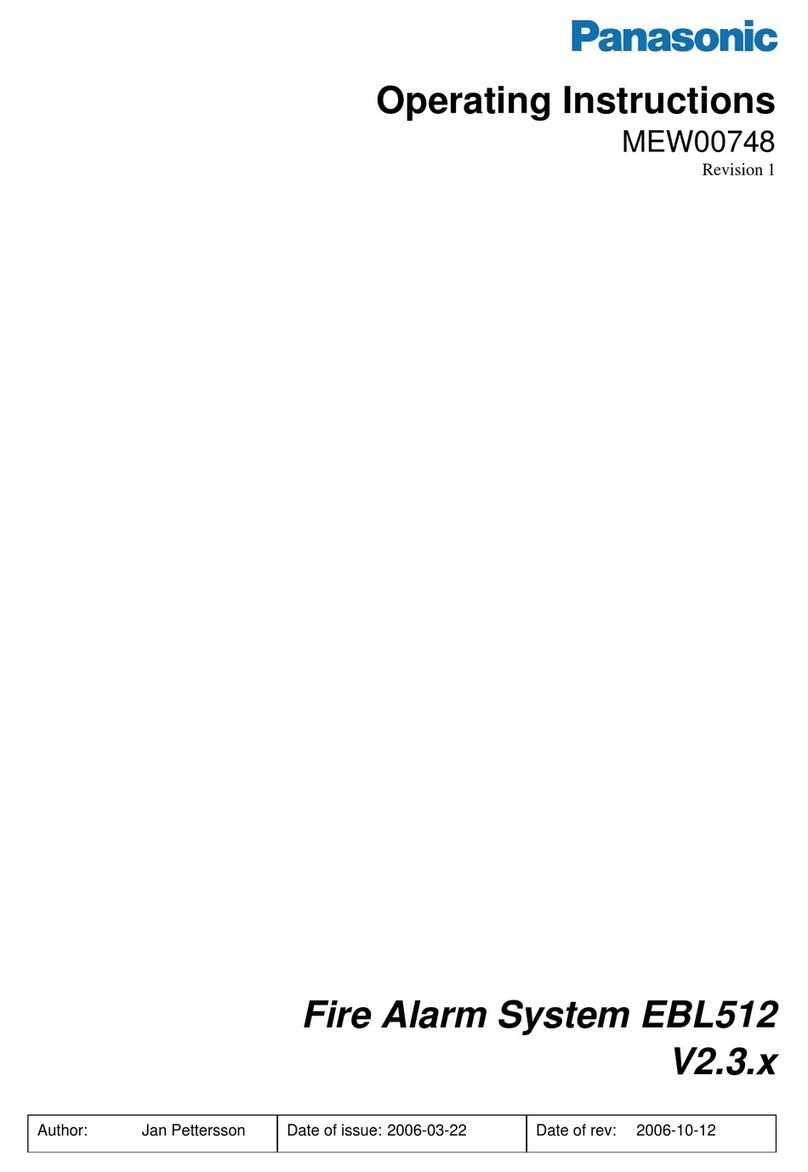SharpEye 20 Operating instructions

Mini Triple IR (IR3) Flame Detector
Model 20/20MI
User and Maintenance Manual
TM 787100, Rev. D April 2011
ATEX (Cenelec) Approved
Ex II 1 GD, EEx ia IIC T5 (+65ºC), T4 (+85ºC)
218 Little Falls Rd., Cedar Grove, NJ 07009 USA;
Phone: +1 (973) 239 8398 Fax: +1 (973) 239 7614


The SharpEye Optical Flame Detector described in this document is the property
of Spectrex, Inc.
No part of the hardware, software or documentation may be reproduced,
transmitted, transcribed, stored in a retrieval system, or translated into any
language or computer language, in any form or by any means, without prior
written permission of Spectrex, Inc.
While great efforts have been made to assure the accuracy and clarity of this
document, Spectrex, Inc. assumes no liability resulting from any omissions in this
document, or from misuse of the information obtained herein. The information in
this document has been carefully checked and is believed to be entirely reliable
with all of the necessary information included. Spectrex Inc. reserves the right to
make changes to any products described herein to improve reliability, function, or
design, and reserves the right to revise this document and make changes from
time to time in content hereof with no obligation to notify any persons of revisions
or changes. Spectrex, Inc. does not assume any liability arising out of the
application or any use of any product or circuit described herein; neither does it
convey license under its patent rights or the rights of others.
Warning:
This manual should be carefully read by all individuals who have or will have
responsibility for using, maintaining or servicing the product.
The Detector is not field-repairable due to the meticulous alignment and
calibration of the sensors and the respective circuits. Do not attempt to modify or
repair the internal circuits or change their settings, as this will impair the system's
performance and void the Spectrex, Inc. Product warranty.


Spectrex Inc. - SharpEyeTM Mini IR3 Flame Detector Manual – TM 787100, Rev. D April 2011
I
TABLE OF CONTENTS
1. Scope.....................................................................................................1
1.1 PRODUCT OVERVIEW .....................................................................................1
1.2 DOCUMENT OVERVIEW...................................................................................2
2. Technical Description.............................................................................3
2.1 PRINCIPLES OF OPERATION............................................................................3
2.1.1 Hydrocarbon fire detection....................................................................3
2.1.2 Identifying the CO2peak.......................................................................3
2.1.3 The limitations of IR-IR flame detectors................................................3
2.1.4 The advantages of IR3 technology .......................................................3
2.1.5 Modbus RS-485....................................................................................4
2.1.6 Use in Hazardous Atmosphere.............................................................4
2.1.7 Types and Models ................................................................................5
3. Performance...........................................................................................9
3.1 DETECTION SENSITIVITY.................................................................................9
3.2 CONE OF VISION .........................................................................................11
3.3 FALSE ALARMS PREVENTION ........................................................................12
4. Operation .............................................................................................14
4.1 VISUAL INDICATIONS ....................................................................................14
4.2 OUTPUT SIGNALS ........................................................................................15
4.2.1 Optional latching.................................................................................16
4.2.2 Built-In-Test ........................................................................................16
4.3 Detector Mode Setup.............................................................................16
4.3.1 Detector setting...................................................................................16
4.3.2. Detector’s various functions...............................................................16
4.3.3. Detector Default Set Up.....................................................................18
4.4 BUILT IN TEST .............................................................................................18
4.4.1. General..............................................................................................18
4.4.2. Principles...........................................................................................19
4.4.3. Automatic & Manual BIT....................................................................19
4.4.4. Manual BIT only.................................................................................19
5.Technical Specifications........................................................................20
5.1 ELECTRICAL SPECIFICATIONS .......................................................................20
5.2 MECHANICAL SPECIFICATIONS ......................................................................21
5.3 ENVIRONMENTAL SPECIFICATIONS.................................................................22
6. Installation Instructions.........................................................................23
6.1 SCOPE........................................................................................................23
6.2 GENERAL CONSIDERATIONS .........................................................................23
6.3 PREPARATIONS FOR INSTALLATION................................................................24
6.4 CERTIFICATION INSTRUCTIONS......................................................................25
6.5 CONDUIT INSTALLATION................................................................................26
6.5.1 Tilt Kit P/N 787639..............................................................................26
6.5.2 Tilt installation (Figs. No. 6 and 7) ......................................................26
6.6 DETECTOR MOUNTING .................................................................................29
6.7 WIRING FUNCTION .......................................................................................29

Spectrex Inc. - SharpEyeTM Mini IR3 Flame Detector Manual – TM 787100, Rev. D April 2011
II
6.8 OPERATION MODE.......................................................................................30
7. Operating Instructions..........................................................................31
7.1 SCOPE........................................................................................................31
7.2 POWER-UP.................................................................................................31
7.3 RESET (ONLY WHEN OPTIONAL ‘LATCHING’ ALARM HAS BEEN SELECTED)...........31
7.4 FUNCTIONAL TESTING...................................................................................31
7.4.1 Manual BIT Test .................................................................................32
7.4.2 Testing with Fire Simulator Model 20/20-310 (see Appendix B)........32
7.5 SAFETY PRECAUTIONS.................................................................................33
8. Maintenance Instructions .....................................................................34
8.1 SCOPE........................................................................................................34
8.2 MAINTENANCE INSTRUMENTATION AND PERSONNEL .......................................34
8.3 PREVENTIVE MAINTENANCE PROCEDURES.....................................................34
8.4 PERIODIC MAINTENANCE PROCEDURES.........................................................34
8.4.1 Power-Up Procedure ..........................................................................34
8.4.2 Functional Test Procedure..................................................................34
8.5 MAINTENANCE RECORDS..............................................................................34
8.6 TROUBLESHOOTING .....................................................................................35
8.6.1 Fault Indication ...................................................................................35
8.6.2 False Alarm or Warning Indication......................................................35
Appendix A: Typical Wiring Configurations...............................................37
Appendix B: Intrinsically Safe Connection For 20/20MI-XX-X-C...............43
Appendix C: Long Range IR3 Fire Simulator............................................46
Appendix D: FM Report for 20/20 MI-3.....................................................49
Appendix E: Ordering Information............................................................53

Spectrex Inc. - SharpEyeTM Mini IR3 Flame Detector Manual – TM 787100, Rev. D April 2011
III
LIST OF FIGURES
Figure 1: IR3 Flame Detector ............................................................................................ 6
Figure 2: Flame Detector Assembly - Outline Drawing (Cable output option)................. 7
Figure 3: Flame Detector Assembly - Outline Drawing (Connector output option) ......... 8
Figure 4: Horizontal and Vertical Fields of View............................................................ 11
Figure 5: Indication LEDs................................................................................................ 14
Figure 6: IR3 Detector and Tilt Mount Assembly ............................................................ 27
Figure 7: Tilt Mount Assembly - Outline Drawing........................................................... 28
Figure 8: Connector Interface Option.............................................................................. 37
Figure 9: Cable Interface Option..................................................................................... 38
Figure 10: RS-485 Networking......................................................................................... 39
Figure 11: 4-20mA Wiring (Sink Option)......................................................................... 40
Figure 12: 4-20mA Wiring (Source Option)..................................................................... 40
Figure 13: Typical Wiring For 4 Wire Controllers.......................................................... 41
Figure 14: 4-20 mA (sink) connection for Intrinsically Safe installation......................... 44
Figure 15: RS-485 connection for Intrinsically Safe installation..................................... 45
Figure 16: Fire Simulator................................................................................................. 46
Figure 17: Mini IR3 Detector Target Point...................................................................... 47
LIST OF TABLES
Table 1: Alarm Response Time Versus Range – 20/20MI-1............................................... 9
Table 2: Alarm Response Time Versus Range – 20/20MI-3............................................... 9
Table 3: Response Sensitivity Ranges............................................................................... 10
Table 4: Sensitivity to other fire sizes............................................................................... 10
Table 5: Immunity To False Alarm Sources..................................................................... 12
Table 6: Welding Immunity Distance – 20/20MI-1 .......................................................... 13
Table 7: Welding Immunity Distance – 20/20MI-3 .......................................................... 13
Table 8: Output Signals versus Detector State................................................................. 15
Table 9: Sensitivity range ................................................................................................. 16
Table 10: Time Delay........................................................................................................ 17
Table 11: Function Setup.................................................................................................. 18
Table 12: Default function set up...................................................................................... 18
Table 13: Contact Ratings................................................................................................ 20
Table 14: Tilt Kit............................................................................................................... 26
Table 15: The detector default set up ............................................................................... 30

Spectrex Inc. - SharpEyeTM Mini IR3 Flame Detector Manual – TM 787100, Rev. D April 2011
IV

Spectrex Inc. - SharpEyeTM Mini IR3 Flame Detector Manual – TM 787100, Rev. D April 2011
1
1. Scope
1.1 Product Overview
The Spectrex Model 20/20MI is a new version of the triple IR spectrum flame
detector designed to provide maximum fire protection. It uses innovative
technology of advanced digital signal processing to analyze the dynamic
characteristics of fire. Three sensitive IR channels process the signals. Detection
performance is controlled by a microprocessor and easily adapted to all
environments, applications and requirements. The result is a unique and superior
flame detector, which provides excellent detection sensitivity with extreme
immunity to false alarm.
This version of IR3 is approved intrinsically safe and manufactured in S.M.T.
Technology. The programmable functions are available through a RS-485 port
used with a standard PC and software supplied by Spectrex or by a handheld
computer.
The detector is ATEX certified to EEx ia IIC T5 (see Appendix B).
To use the HOST software and to change the required functions, refer to manual
TM784050 for instructions.

Spectrex Inc. - SharpEyeTM Mini IR3 Flame Detector Manual – TM 787100, Rev. D April 2011
2
1.2 Document Overview
This manual describes the detector and its features and provides instructions on
the installation, operation and maintenance.
This manual is divided into separate Sections as follows:
Section 1. Scope - a general introduction and overview of the product and the
Manual, with a brief description of its content.
Section 2. Technical Description - the detector’s theory of operation.
Section 3. Performance - the detector features and capabilities.
Section 4. Operation - the detector’s operation modes, user interface and
indications.
Section 5. Technical Specifications - the Detector’s electrical, mechanical and
environmental specifications.
Section 6. Installation Instructions, including wiring and mode setting.
Section 7. Operating Instructions and power-up procedures.
Section 8. Maintenance Instructions and support procedures.
Appendix A. Typical Wiring Configurations - wiring diagrams for
installation.
Appendix B. Intrinsically Safe Wiring Configurations For 20/20MI-XX-X-C
Appendix C. Long Range IR3 Fire Simulator
Appendix D. FM Report for 20/20 MI-3
Appendix E. Ordering information

Spectrex Inc. - SharpEyeTM Mini IR3 Flame Detector Manual – TM 787100, Rev. D April 2011
3
2. Technical Description
• Detection Range: up to 132 ft (40m) for a 1 ft2(0.1m2) fire.
• Ultra High Immunity to False Alarms (see section. 3.3).
• Advanced Digital Processing of the Dynamic Characteristics of Fire:
Flickering, Threshold correlation and Ratio.
• Three Separate IR Channels: Between 3-5 microns.
• Field Programmable Sensitivity: four ranges.
• Two Response Levels: Warning & Detection.
• Solar Blind
• Microprocessor Based: Digital signal processing.
• Built In Test (BIT): Manual and Automatic (see section. 4.4).
• Electrical Interface:
o Dry contact relays (non-Ex version).
o Communication network RS-485.
o 4-20mA output.
• Certification: ATEX (Cenelec)
2.1 Principles Of Operation
2.1.1 Hydrocarbon fire detection
The triple IR flame detector detects all conceivable types of hydrocarbon fires, i.e.
any fire, which emits CO2.
2.1.2 Identifying the CO2peak
The hydrocarbon fire is characterized by a typical radiation emission. The CO2
peak emits intense radiation in the spectral band between 4.2 µ - 4.5 µ and
weaker radiation intensity outside this spectral band.
2.1.3 The limitations of IR-IR flame detectors
CO2in the atmosphere attenuates the radiation in this spectral band. (Absorption
and emission of radiation always occur in the same band.) As a result, the greater
the distance between the detector and the fire, the weaker the intensity of the
radiation reaching the detector (the CO2attenuation increases). This phenomenon
explains the limitations of the existing IR-IR flame detectors in the market:
• Detection distance is restricted to 33ft (10 m) only.
• Their immunity to false alarm sources is limited.
2.1.4 The advantages of IR3 technology
To overcome these limitations, Spectrex Inc. devised an innovative concept of
utilizing an additional detection channel. Three channels collect more data from
the environment, permitting more accurate analysis and better performance.

Spectrex Inc. - SharpEyeTM Mini IR3 Flame Detector Manual – TM 787100, Rev. D April 2011
4
After careful investigation, three channels were selected which, when operating
jointly, provide optimal fire detection characteristics:
Channel 1: 4.2 µ - 4.6 µ
Fire - the CO2peak
Channel 2: 4.0 µ - 4.2 µ
Eliminates false alarms from high temperature sources.
Channel 3: 4.8 µ - 5.2 µ
Eliminates false alarms from flickering of background radiation.
Most IR sources, which create misleading IR alarm stimuli, including the sun,
incandescent and halogen lamps, electric arc discharges, electrical heaters, etc.,
do not possess this unique spectral signature of fire.
The IR sensors of the detector respond only to flickering of radiation signals. The
signals are compared to a predetermined threshold. Processing of the results from
the three IR channels is performed by the board microprocessor. The result is a
much greater detection distance and a highly increased ability to distinguish
between fire and false alarms.
This sophisticated technology surpasses all other existing flame detection
techniques on the market today.
This unique flame analysis capability (patent pending) has been
incorporated into the Triple-IR fire detector manufactured by Spectrex, Inc.
The result is a unique flame detector, which does not produce false alarms
and provides at the same time detection over greatly increased distances.
2.1.5 Modbus RS-485
For more advanced communication 20/20MI has a RS 485 modbus Compatible
output that provides Data communication from a network (up to 247 detectors) to
a host computer on universal controller for central monitoring.
This feature enables easy maintenance local and remote diagnostic tools.
2.1.6 Use in Hazardous Atmosphere
The 20/20MI certified version is intrinsically safe, classified to
ATEX EX II 1GD T 1 23 ºC per SIRA 04 ATEX 2010 (for St.St housing)
and SIRA 04 ATEX 2011X (for aluminum housing)
EEx ia IIC T4 (Ta= -40ºC to + 85ºC)
EEx ia IIC T5 (Ta= -40ºC to + 65ºC)
The detectors are suitable for use in hazardous zones 0, 1 and 2 where group IIC
gasses and vapor are present.
In order to comply with the intrinsic safety requirement, barriers must be
incorporated (in the safe area) and there will be restrictions on cable types and
lengths. The detailed parameter will be dependent on the type of barrier used.
See Appendix B for I.S. wiring detail

Spectrex Inc. - SharpEyeTM Mini IR3 Flame Detector Manual – TM 787100, Rev. D April 2011
5
2.1.7 Types and Models
The 20/20MI has two models:
Standard - up to 40m
Short range - up to 10m.
Optional:
The output is via either a connector or a cable tail (up to 2m long).
C - ATEX certified Per EX II 1GD, EEx ia IIC T4 or T5 (this model is available with
4-20mA and RS-485 outputs only)
F- FM – functional test only - model 20/20 MI-3.
* Cable for connection to junction box
** Mating connector supplied with detector

Spectrex Inc. - SharpEyeTM Mini IR3 Flame Detector Manual – TM 787100, Rev. D April 2011
6
Figure 1: IR3 Flame Detector

Spectrex Inc. - SharpEyeTM Mini IR3 Flame Detector Manual – TM 787100, Rev. D April 2011
7
Figure 2: Flame Detector Assembly - Outline Drawing (Cable output option)

Spectrex Inc. - SharpEyeTM Mini IR3 Flame Detector Manual – TM 787100, Rev. D April 2011
8
Figure 3: Flame Detector Assembly - Outline Drawing (Connector output option)

Spectrex Inc. - SharpEyeTM Mini IR3 Flame Detector Manual – TM 787100, Rev. D April 2011
9
3. Performance
3.1 Detection Sensitivity
Detection sensitivity is the maximum distance at which the detector will reliably
detect a specific size of fire & typical type of fuel (standard fire).
Standard Fire:
A 1ft2(0.1m2) Gasoline pan fire with max. wind speed of 6.5 ft/sec (2 m/sec).
Sensitivity Ranges:
The detector has four user selectable sensitivity ranges. For each range there are
two response levels.
1. WARNING (Pre-alarm)
2. ALARM
The detection distance, for the WARNING level, is approximately 10% higher than
the ALARM distance. Alarm response times for a “standard fire” at a specified
range are shown hereunder.
Table 1: Alarm Response Time Versus Range – 20/20MI-1
10 20 30 40
Sensitivity Range – ft (m) 33 (10) 65 (20) 100 (30) 132 (40)
Response Time (sec) 5 8 10 10
Table 2: Alarm Response Time Versus Range – 20/20MI-3
2.5 5 7.5 10
Sensitivity Range – ft (m) 8.2 (2.5) 16.5 (5) 24.7 (7.5) 33 (10)
Response Time (sec) 1 1 2 3
For some typical ambient conditions the Zeta parameter as defined in NFPA 72 for
the detector is 0.005 (1/meter).
Note:
Zeta parameters may vary significantly with changes in temp, air pressure,
humidity, visibility conditions, etc.

Spectrex Inc. - SharpEyeTM Mini IR3 Flame Detector Manual – TM 787100, Rev. D April 2011
10
Other fuels
The detector will react to other types of fires as follows:
Pan Fire Size: 1ft2(0.1m2)
Maximum Wind Speed: 6.5 ft/sec (2 m/sec)
Maximum Response Time: 10 sec
Table 3: Response Sensitivity Ranges
Type Of Fuel % Of Max. Distance at
each Sensitivity Range
Gasoline 100%
N-Heptane 100%
Alcohol 95% 75%
JP4 75%
Kerosene 75%
Diesel Fuel 70%
Methane* 30%
Propane* 30%
* 0.5m plume fire
Table 4: Sensitivity to other fire sizes
Fuel Fire Size Detection
Sensitivity Distance Maximum Detection Time
20/20MI-1
Jet Fuel 2 x 2 ft 40 132 ft (40m) 10 seconds
Jet Fuel 2 x 2 ft 20 65 ft (20m) 8 seconds

Spectrex Inc. - SharpEyeTM Mini IR3 Flame Detector Manual – TM 787100, Rev. D April 2011
11
3.2 Cone Of Vision
Horizontal: 100°
Vertical: 100°
Figure 4: Horizontal and Vertical Fields of View

Spectrex Inc. - SharpEyeTM Mini IR3 Flame Detector Manual – TM 787100, Rev. D April 2011
12
3.3 False Alarms Prevention
The detector will not provide an alarm or a warning signal as a reaction to the
radiation sources specified below.
Notes:
IAD = Immune at Any Distance.
All sources are chopped from 0 to 20Hz.
Table 5: Immunity To False Alarm Sources
Radiation Source Immunity
Distance ft(m)
Sunlight IAD
Indirect or reflected sunlight IAD
Incandescent frosted glass light, 100 W IAD
Incandescent clear glass light, rough service, 100 W IAD
Fluorescent light with white enamel reflector, standard office or
shop, 40 W (or two 20 W) IAD
Electric arc [12mm (15/32 in) gap at 4000 V alternating current,
60 Hz] IAD
Arc welding [4 mm (5/32 in) rod; 240 A] See Table 6, 7
Ambient light extremes (darkness to bright light with snow, water,
rain, desert glare and fog) IAD
Bright colored clothing, including red and safety orange. IAD
Electronic flash (180 watt-seconds minimum output) IAD
Movie light, 625 W quartz DWY lamp (Sylvania S.G.-55 or
equivalent) 6.5 (2)
Flashlight (MX 991/U) IAD
Radiation heater, 1500 W IAD
Radiation heater, 1000 W with fan IAD
Quartz lamp (1000 W) 10 (3)
Mercury vapor lamp IAD
Grinding metal IAD
Lit cigar 1 (0.3)
Lit cigarette 1 (0.3)
Match, wood, stick including flare up 10 (3)
This manual suits for next models
1
Table of contents
